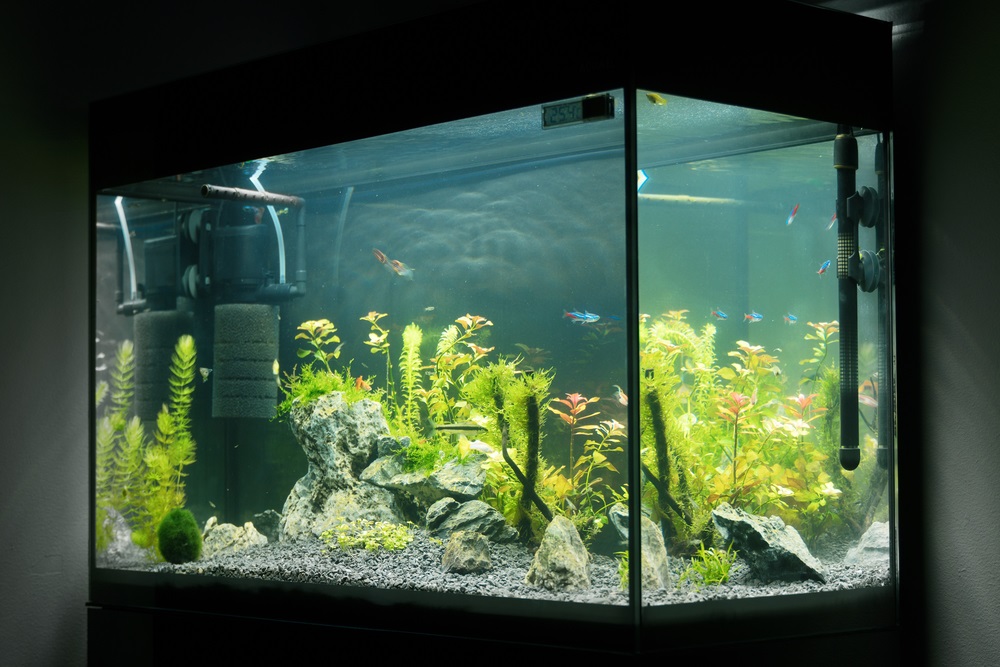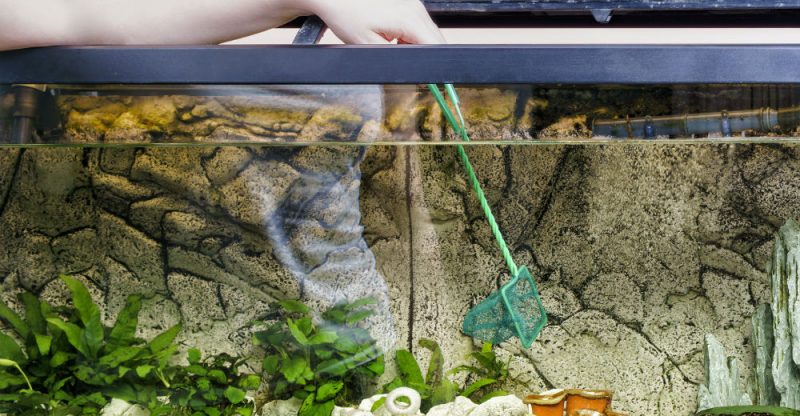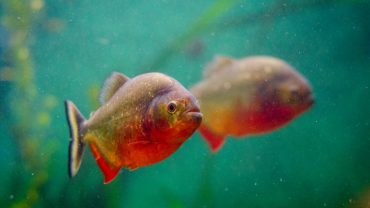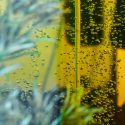Purified Water Vs Distilled Water For Fish Tank
The best water for a fish tank is one that contains healthy minerals and has no dangerous contaminants like chlorine, hydrogen sulphide and pesticides.
While it may seem like purified water and distilled water are perfectly safe for fish, they need additional treatments to be suitable for a fish tank.
In this guide, we compare purified water vs. distilled water for a fish tank. We also discuss other aquarium water sources.
What Kind of Water do Fish Need?

Obviously, water is the most important component of your aquarium. The quality of the water determines how healthy your fish are and even whether they survive beyond a few days.
So the kind of water you use matters a great deal. It needs to have the good stuff and lack the bad stuff.
What should be in aquarium water:
- Minerals and trace elements such as calcium, magnesium, phosphorus, iron and zinc. These are crucial for the health and survival of all kinds of fish. Planted aquariums also need them.
- Dissolved oxygen is critical for fish to live, similar to the way humans need oxygen gas. If the water doesn’t have adequate oxygen (e.g. well water), it can cause problems for the fish.
What should NOT be in aquarium water:
- Chlorine or chloramine. Both of these are toxic to fish.
- Ammonia, nitrites and other contaminants in polluted water
- Pathogens.
Based on these, you can choose the right water for your fish tank and know which water sources to avoid.
Generally, most potable water sources including distilled water, bottled water, tap water and even well water are okay for use in a fish tank. But you almost always need to treat the water to make it safe for the fish.
The kind of treatments you add depends on what type of aquarium you have (saltwater or freshwater) and the fish you keep.
Purified vs. Distilled Water: Which Is The Best Option for a Fish Tank?
Purified water is water that has gone through a multi-step filtration process to remove contaminants such as bacteria, viruses and chemicals. In most cases, water purification also strips out minerals in water.
Examples of purified water include reverse osmosis (RO) water. Even distilled water is a type of purified water.
Distilled water is made by boiling contaminated water. The resulting steam is then collected and cooled back into purified water that’s virtually free of chemicals, pathogens and minerals.
So purified and distilled water are very similar. They are safe for use in an aquarium since they don’t have dangerous contaminants, but you need to re-mineralize them.
One thing to keep in mind is that distilled water can be quite expensive to buy, which will make your fish tank pricier to maintain.
You can buy a home distiller, but it’s not cheap.
Purified water is much easier and cheaper to make at home. An under-sink RO water purifier is not that expensive and it uses very little electricity to run.
There are even portable and table-top RO systems if you don’t want the hassle of plumbing one under your sink.
Other Aquarium Water Sources
1. Tap Water
For most aquarium owners, tap water is the easiest source of water for their fish tank. It’s plentiful, cheap and usually free of most contaminants.
It also contains the minerals your fish need, so you don’t need to worry about re-mineralizing it.
The biggest concern with tap water is the chlorine or chloramine used to treat it. You need to add a dechlorinator to the water to neutralise the chlorine or chloramine.
Another concern is lead, which is highly toxic to fish (and humans). Tap water in the UK doesn’t contain lead, but old plumbing in your home can introduce lead into the water. If your home was built before 1970, test your water for lead.
Water hardness is usually not a major concern when it comes to using tap water in a fish tank. Most fish and plants can adapt to a wide range of water hardness levels.
But be cautious if you live in an area with a very high level of water hardness (over 12 GPG or 205 ppm). It can affect some fish or cause algae to bloom. Consider softening the water before adding it to the aquarium.
Here’s a great video on how to test water hardness as well as pH and carbonate hardness (KH).
2. Well Water
Well water has plenty of the minerals your fish and aquarium plants need. It also doesn’t have any chlorine.
On the downside, groundwater can harbour dangerous impurities especially if the well is exposed to pollution.
Before using well water in the aquarium, we recommend getting it professionally tested. You are looking for any dangerous chemicals like hydrogen sulphide, ammonia, pesticides and volatile organic compounds.
We also recommend running the water through a well water filter to get rid of heavy metals, sediment and other impurities. Filtration also removes excessive iron which can be bad for the fish.
It’s also a good idea to check the hardness of the water. If it is over 12 GPG, use a water softener.
Another issue with well water is low oxygen concentration. You can solve this by using an air pump in your fish tank. This will create water movement, which increases the amount of dissolved oxygen.
3. Filtered Water
Filtered water and purified water are not the same.
Both types of water go through multiple purification processes. But purified water undergoes an extra step — reverse osmosis or distillation — to remove almost all impurities.
Filtered water, on the other hand, only removes some of the impurities in water.
Most water filters will remove chlorine, sediment, and various chemicals from the water. But they’ll not fully eliminate germs and viruses, certain chemicals, and heavy metals. They also do not strip the water of its minerals.
Most home water filters are great for use with tap water. They are great at removing chlorine, though you should still run a chlorine test on the filtered water.
For well water, you need a special filter that can remove heavy metals, rust, and various chemicals.
You typically don’t need to remineralize filtered water.
4. Reverse Osmosis Water
Reverse osmosis or RO water is purified water. So the same pointers we gave on purified water above also apply to RO water.
The most important thing to remember is that RO water doesn’t have the necessary minerals for fish. So you’ll need to add minerals. Don’t forget to also check the pH.
Other than that, the water is safe to use in a fish tank. It doesn’t contain chlorine, dangerous chemicals, pathogens or heavy metals.
5. Bottled Water
Bottled water is generally purified water. Companies use distillation, deionization or reverse osmosis to treat the water before bottling it.
They’ll then add back minerals to improve taste and make it healthier.
You can certainly use bottled water in a fish tank (after carrying out all the usual tests), but it can get expensive fast.
It’s also important to confirm that the water contains minerals. Some companies sell RO or distilled water as it is. Do a TDS test to see how much dissolved solids are in the water.
If you get a low TDS (under 200 PPM), you’ll need to add minerals to the water.
6. Rain Water
If you trap and store rainwater, you can use it in a fish tank. Just like any other water source, you need to test it to make sure it is safe. You may also need to treat it.
Rain water is not always pure. It can contain chemicals and pathogens that are dangerous to the fish.
We recommend disinfecting/purifying and filtering rain water before using it in a fish tank. You can use chlorine to disinfect it then run it through a filter to remove chemical impurities.
Alternatively, use an RO system to purify and filter it. Also make sure you measure the hardness, TDS and pH of the water and adjust if necessary. You most likely need to add minerals to it.
Bottom Line
Every aquarium owner has the kind of water they prefer to use. Any of the water sources we’ve mentioned above is fine for use in a fish tank.
What matters most is how you treat the water before adding it to the aquarium. Depending on the water source, you may need to filter, purify, dechlorinate or re-mineralize it.
If you are not sure which water to use, your tap water is great. Just dechlorinate it and check the pH and it’s ready for use without requiring any additional treatments.





